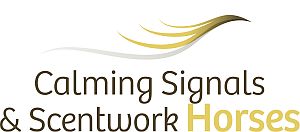Lectures & Workshops
You can invite Rachaël for lectures, workshops or combined educational weekends about Calming signals of horses, and Equine mental stimulation and scentwork. Rachaël lectures on the following subjects:
Calming Signals of Horses
1-day theory with films and pictures or 1-day theory with films and pictures & observation sessions of horses
By watching numerous pictures and films (or pehaps live demonstrations) of domesticated horses reacting to stimuli in their environment, you will emerge in the fascinating world of Calming signals of horses. You will start to recognise them, and will see variations. From a horse being relaxed to a horse that is experiencing rising or declining tension. By recognising various behaviours and features of the horse, this day is a good practise to further sharpen your observation skills. 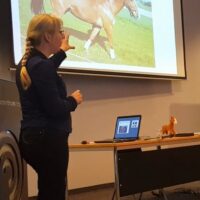 After this day you are more astute to recognise at what tension level your horse is at. You will get tools on how to implement the knowledge of calming signals in your daily living and work with horses. And will be shown and practising how you can use calming signals yourself to further improve the relationship with your horse and your mutual understanding, your life and training. Some topics we cover:
After this day you are more astute to recognise at what tension level your horse is at. You will get tools on how to implement the knowledge of calming signals in your daily living and work with horses. And will be shown and practising how you can use calming signals yourself to further improve the relationship with your horse and your mutual understanding, your life and training. Some topics we cover:
Introduction
• Personal background
• Information on the study, how is it conducted, what are the parameters used.
• Information about communication, when are signals used to communicate and when not.
The Calming Signals
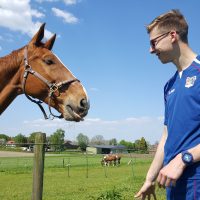 • What are calming signals?
• What are calming signals?
• What do they look like?
• When do we see them?
• How does no, light or high tension play a role in relation to the calming signals?
• The calming signals are shown one by one on picture and film. (with also the comparison of the non-communicative options).
Tension is increasing
• How do calming signals relate to displacement activities and if tension rises further to stress signals.
• How can you tell, within several levels of tension, if the tension is increasing or decreasing.
• How does it look like when distance increasing signals are added in the picture
• A short biological explanation what stress does to the body
Applications
- How do we use this knowledge on calming signals
- Can we mimic the calming signals. Does our horse understands us better?
- Which calming signals can we use to help the horse decrease tension, or stay in a relaxed base.
This lecture is full of pictures and films to make sure you get a varied and broad spectrum of horses reacting to stimuli while experiencing no tension or various tension levels. Do you want to work with real horses? Contact Rachaël to discuss the extra possibilities.
Calming signals in practice
1-day filled with practical work
During this day Calming Signals in practice we leave the pictures and film clips behind and start interacting with the horses in arena’s, paddocks and pastures. Under supervision of Rachaël Draaisma we will conduct exercises, that have the following learning goals:
- Observation of the horses in various settings
- Practice making calming signals towards a horse
- Practice to help someone else make calming signals towards a horse
During the practical sessions in the midday, a work setting horse-human is set up. This work setting is determined by the organizer and has a direct link to his work and the participants who are invited. This might for example be:
- Multiple coaching’s sessions
- Groundwork with horses
- Lessons in various disciplines, like dressage, jumping, western or agility
- Mental stimulation & Scentwork with horses
- Other, namely…
In this work-setup attendants can immediately put in practice what they have learned in the morning exercises and thus apply it to their field of interest. Rachaël Draaisma acts as observator in the midday program and if needed apply suggestions for improvement. The organiser may choose to have a leading role in this midday program so he or she can fully represent their work of interest.
Obviously, the starting point of this entire day is that both horse and human feel safe and comfortable and enjoy the various program components.
This day is a logic follow-up from the Calming signals lecture and is only applicable for those who have already attended that day.
Mental Stimulation & Scentwork for Horses
1-day theory with films and pictures or 1 day theory with films and pictures & live demonstrations
“A reduction in stress, less spooky reactions, a feeling of wellbeing and pleasure, a better socialisation, better use of the body. These are some advantages of the use of mental stimulation and scentwork for horses. Speaking is Rachaël Draaisma. During her day lecture ‘Mental Stimulation & Scentwork with horses’ she will show you how you can use both disciplines in your life and work with horses. You will get theory and are shown many photos and films (or live demonstrations) . After this lecture you are able to start yourself. This day is a logic follow-up from the lecture Calming Signals of Horses’. Some topics we cover:
Part 1: Mental stimulation
• What is mental stimulation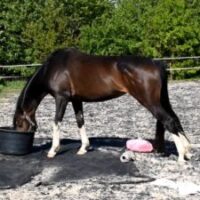
• What effect does it have on the development of the horse, his behaviour and brain• How can you optimize exercises, what are pitfalls.
• How to use mental stimulation as a primary tool when (re)socialising and training horses
• How to use mental stimulation when solving behavioural issues. A study case of a horse with separation anxiety is being shown on film
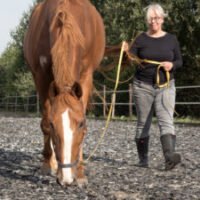
Part 2: Scentwork with horses
• Why is scentwork so beneficial for horses?
• From scent molecule to brain signal, what happens when you scent?
• Advantages from scentwork on the behaviour and wellbeing of horses
• Bio mechanic; the advantages of scentwork on the development of the horses’ body
• How to get started? What do you need
• How to lay a track
• What challenges do I encounter? How do I solve these
• We follow several horses that are taught to follow a footstep track.
This lecture is full of pictures and films to make sure you get a varied and broad spectrum of domesticated horses who are taught to do scent tracking or are offered mental stimulation.
Scentwork for Horses
1-day filled with theory and practical sessions
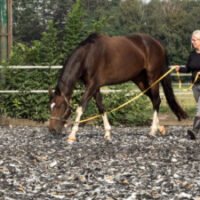
During this day you will emerge yourself in ‘Scentwork for Horses”. You will get theory and are shown many pictures and films, but we will also be working with live horses. The theoretical parts will alternate with those practical parts. After this lecture yo are able to start scentork for horses by yourself. Some of the topics we cover:
• Why is scentwork so beneficial for horses?
• From scent molecule to brain signal, what happens when you scent?
• Advantages from scentwork on the behaviour and wellbeing of horses
• Bio mechanic; the advantages of scentwork on the development of the horses’ body
• How to get started? What do you need
• How to lay a track
• What challenges do I encounter? How do I solve these
• We follow several horses that are taught to follow a footstep track.
When this lecture is being held for coaches that work with clients. We will also look at the benefits and challenges scentwork for horses can give for coach and client.
After this lecture you will know more about the scent abilities of the horse. You know more on the several advantages scentwork has for the horse, on his wellbeing, his body and brain, You are able to start doing scentwork with horses yourself.
Horse empowering (re) socialisation
2- day’s filled with theory and practical sessions
These 2 days evolve around socialising and re-socialising horses. This may be:
- young horses you are going to start up,
- horses that need resocialisation because they show flight behaviour to specific or many stimuli around them.
- horses that will undergo a change in life, for instance traveling, moving house, going to competitions
- horses that have very little to no opportunities to explore and play in their life
Program:
Day1:
Morning program:
In classroom: Assessment of emotional state of horses. Looking at features and behaviours on a detailed level. How can we asses when they are in their comfort zone, when outside. If they experience tension, what level of tension is that? Many photos and films are being used to practice.
Goal: Set in a shorter time frame a baseline for assessing the horses wellbeing, motivation and tension level, in films and practical sessions of exploration and scentwork, we are going to see in the midday on Saturday and Sunday.
Lunch
Midday program:
In classroom: short introduction why horse empowering socialisation (HES) is so needed. Followed by what you need to know about the horse and owner before getting started in practice. Followed by
Practical sessions with horses:
With a different variety of horses we establish a good starting point for the horse empowering socialisation. With each horses we make a setting that starts and stimulates their exploratory behaviour. We will we doing that by using scentwork & building customised enriched environments.
In classroom: summary of the midday practical sessions.
Day 2:
Morning Program:
In classroom: Diving into the world of exploration and scentwork. I talk about the effect it has on the development of the horse, his behaviour and brain, How can you optimize exercises, what are pitfalls. How to use mental stimulation and scentwork as a primary tool when (re)socialising and training horses.
Lunch
Midday Program:
Practical sessions with horses
In classroom: summary of the midday practical sessions and take home messages.
When you have followed this weekend, you will:
- You have a good starting point on how to get started with HES with your own horse.
- You know the basic positive effects it has for your horse and you
- You know pitfalls you have to keep in mind and ways to expand the explorative behaviour of your horse
- Likely can’t wait to get started with your own horse.
General Information
Costs
For a full day: between 750,- and 900,- euro (excluding VAT) depending on the travel distance. Travel costs, sleeping accommodation and costs for food and drinks should be taken care of by the host.
Equipment needed
An overhead projector, a whiteboard or flip chart and a table and chair. The time table can vary, but never more than 8 hours per day, and ending no later than 6 pm.
When working with horses, these horses are at home at the venue the event is taking place. The number of attendants should be to that amount that the horses can handle them and viewers have good sight at the arena’s. The horse is always leading in the programs.
